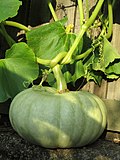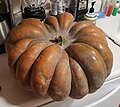商品描述
A LA CARTE
🚚 最快送貨時間 : 隔日送。
🐝 供應商 / 產地:A LA CARTE / 土耳其
🔖 認證: 歐盟有機認證
🌱 生產商介紹:
我們選擇供應商是因為他們對產品的熱愛,
追求最好的質量,同時尊重傳統的生產方法。
其中大多數是 家族擁有的,大小與人一樣。我們重視與他們的直接合作。
透過直接從源頭採購,我們很自豪能為當地經濟做出貢獻,
同時確保我們的客戶最終以最優惠的價格獲得最美味、最新鮮的產品。
我們所有的農民都遵循特定的認證,以最大限度地減少化學品的使用。從永續農業「Agriculture Raisonnee」(AR)到有機認證的「Agriculture Biologique」(AB),這些保證了為您提供安全健康的水果。
🌱 供應商產品:
🛍 產品資訊 (主要):
動植物學名:Cucurbita moschata (Duch) Poir.
中文名稱:南瓜
英文名稱:Pumpkin
其他名稱:番瓜、倭瓜、桃南瓜、伏瓜、金爪、飯瓜、窩瓜
產品介紹:食用功效
味甘,性溫,有消炎止痛、解毒祛蟲、補中益氣、益脾暖胃、充飢養中之療效。南瓜含澱粉質和纖維素,帶來充飢飽腹和補充體力之效果;其所含類胡蘿蔔素及所屬的葉黃素,則帶來保護眼睛和視力的作用;此外,南瓜還含有益心臟健康的鎂質和鉀質成分,有益心臟健康。有研究指南瓜能黏結和消除鉛、汞等有毒金屬,且能降低亞硝酸鹽的致癌性,同時能增強肝腎的再生能力,因而有防禦過量有毒金屬的累積,有助預防環境中毒。
✔️營養密度非常高,低卡路里,豐富的膳食纖維,維持好健康。
✔️富含維生素A、E、C、β-胡蘿蔔素、菸鹼酸、葉酸,葉黃素和粟米黃素,能保護眼睛及預防病變。
原產於中南美洲。14世紀傳入中國,主要分佈於中國、印度和日本,歐、美較少栽種,故有學者誤認為原產於中國,故有「中國南瓜」之稱。現世界各地均有栽種,但仍以中國南方栽培為最多。
品種:南瓜的品種較多,形狀、大小、顏色、用途各異。作蔬菜用的主要是中、小型品種,適合做菜、煮湯;大型南瓜果重可達數十千克,但因不太適宜食用,所以主要用作裝飾物;小巧而造型特殊的「玩具南瓜」則以用作觀賞和擺設為主。形狀視乎不同的品種,果實一般呈扁圓形或球形;瓜皮以深橘色居多,亦有品種的瓜皮為綠色的品種,而且附有彩色的花紋,甚多變化;直徑約為 20 至 80 厘米。南瓜為一年生攀援草本;根系發達。 莖蔓生,五棱;葉掌狀五裂,缺刻淺,深綠色,葉脈交界處有不規則斑紋。
另外,本植物有兩個變種:其一為圓南瓜(C. moschata var. melonaeformis),果實呈扁圓形,果面有縱溝或瘤狀突起,外皮深綠色,有黃色斑紋,如廣東的「盒瓜」;另一種為長南瓜(C. moschata var. toonas),果實呈長形,頭部膨大,外皮綠色,有黃色花紋,如江蘇的「牛腿番瓜」。
供應季節:主要生收成期為每年5月至10月,香港全年均有供應。
儲存方法:1.整個南瓜放置在陰涼亁燥通風處,室溫保存1-2個月左右。
2.切開後容易從心部開始變質,如要保存,可將內部瓜子瓜囊挖空,再用保鮮膜包好冷藏,約可保存 2 周。
#宜忌:
宜:適宜肺痛、哮喘、痛腫者,患有高血壓、便秘、癌症病患者,燙傷、被毒蜂螫傷之人士食用。
忌:因南瓜含鉀量高,腎功能不良、尿毒症者宜少食。患有黃疸型肝炎、麻疹、腳氣等症的患者,水痘、氣滯濕阻者忌食。
懷孕宜吃南瓜
孕婦在懷孕期間吃南瓜可以促進消化、緩解便秘的作用,但是過量食用的話容易造成體內濕熱,不建議每天吃,食用量也要控制。
屬性 溫性
五味 甘
功效 消炎止痛、解毒祛蟲、補中益氣、益脾暖胃、充飢養中
主要營養
南瓜富含維他命A,能加快細胞分裂速度,刺激新細胞的生長。 豐富的鈷能增強體內新陳代謝,促進造血功能,並促進人體內維他命B12的合成。
*食用配伍:
相宜搭配
相宜 功效
牛肉 補脾健胃、解毒止痛
綠豆 清熱解毒、生津止渴
不宜搭配
相剋 影響
羊肉 引起黃疸和腳氣
蝦 導致腹瀉、腹脹
辣椒 破壞維他命C
鯉魚 引起中毒
蟹 容易腹痛、腹瀉
#備註事項:不宜多食。多食則易生濕發黃,令人腹脹。南瓜因其富含類胡蘿蔔素,過量食用會產生皮膚變黃現象。多食南瓜會助長濕熱。南瓜子亦會用作製作成醬油瓜子。
常用菜式:
南瓜粉蒸肉、黃金南瓜餅、南瓜排骨煲。
南瓜派是一種流行的南瓜製作方法
烤南瓜
伊朗亞塞拜然大不里士的胡桃南瓜醬
南瓜葉泡菜
萬聖節時將南瓜雕成南瓜燈
🔹 產品資訊 (補充):
Jack Be Little Squash 具有溫和的堅果味和柔軟可食用的外皮。它們體積小,非常適合單獨食用。煮熟後,它們具有微甜和泥土的味道,使其成為各種菜餚中的多功能成分。
這些微型南瓜非常適合餡料、烘烤或炒。其獨特的尺寸使其非常適合單獨的開胃菜或配菜。想要一道美味且視覺上吸引人的菜餚,請嘗試著名烹飪網站上的釀傑克比小南瓜食譜。
此產品為外國進口,供應視乎到貨情況,有可能數量不足或缺貨!
建議食用方法:
食用部份位於瓜果。稍為沖洗後,削去外皮,去種子。
食用方法:南瓜派、南瓜濃湯、南瓜米粉、南瓜粥、南瓜飯、涼拌南瓜
1.炒南瓜子:將纖維與黏液搓洗乾淨,稍微晾乾後,乾鍋不放油用微火炒熟就是我們吃的南瓜子
2.蒸:將外皮用海綿刷洗乾淨,較大的切對半,放入電鍋中蒸煮即可
3.將南瓜切塊(可削皮或不削皮)與飯一起蒸煮,飯好即可食用
xxxx
| Image |
Description |
|
Al Hachi |
Cucurbita moschata |
Kashmir |
The people of Kashmir dry Al Hachi pumpkins to eat in the winter, when snowfall can isolate the valley. |
 |
Big Max |
Cucurbita maxima |
United States |
Big Max can exceed 100 pounds (45 kg) and 20 in (510 mm) in diameter under ideal growing conditions. The variety was hybridized for its size during the early 1960s. Individual fruits are round to slightly flattened. |
 |
Calabaza |
Cucurbita moschata |
Cuba and West Indies |
The calabaza is a variety originating in Cuba and the West Indies. It is also cultivated in the Philippines and United States. |
 |
Cheese pumpkin |
Cucurbita moschata |
North America, possibly from an origin in Central America[74] |
So-called for its resemblance to a wheel of cheese, this cultivar has been noted for its long storage ability as well as relatively poor culinary characteristics. One of Duchesne's 1786 botanical illustrations depicts a fruit that has been identified with the Cheese Pumpkin. |
 |
Connecticut field pumpkin |
Cucurbita pepo |
North America[13] |
Considered to be "one of the oldest pumpkins in existence". Widely used for autumn decorations, either whole or as jack-o'-lanterns. |
|
Dickinson pumpkin |
Cucurbita moschata |
North America |
The oblong, ribbed fruits weigh up to 40 pounds and are widely used for canning. Derived from the Kentucky field pumpkin by Elijah Dickinson when he moved to Illinois in 1835. Libby's Select is classified either as a selection from the Dickinson Pumpkin or a selection from the same parent lineage. |
 |
Dill's Atlantic Giant |
Cucurbita maxima |
North America |
Dill's Atlantic Giant was bred by Howard Dill from sources including the Mammoth Pumpkin variety.[83][84] The variety were patented in 1979, who then went on to set the giant pumpkin in 1980 with a 459 lb (208 kg) record. |
 |
Galeux d'Eysines |
Cucurbita maxima |
France |
The Galeux d'Eysines is mentioned in the Vilmorin-Andrieux vegetable catalogue Les Plantes Potagères in 1883. It is noted for peanut-sized growths on its skin, caused by a buildup of sugar. Its name may have originally been Brodé galeux d'Eysines, translating to embroidered with scabs, from Eysines. Immature pumpkins can be etched with words or designs that become warts as it matures. Galeux d'Eysines was reportedly brought to the United States in 1996 from the Foire aux Potirons pumpkin festival in Tranzault, France, by author Amy Goldman. |
 |
Japanese pie pumpkin |
Cucurbita argyrosperma |
Pennsylvania |
The Japanese pie pumpkin is so-called because its seeds become crazed, resembling to Americans the appearance of Chinese characters or Japanese kanji. This variety was introduced by Samuel Wilson of Pennsylvania in 1884. |
 |
Jarrahdale pumpkin |
Cucurbita maxima |
Australia |
A variety with a blue-gray skin, named after the Western Australian town of Jarrahdale. The Jarrahdale closely resembles the Queensland Blue. It cuts easily, and has orange, sweet-tasting flesh. |
|
Jonathan pumpkin[13][90] |
Cucurbita argyrosperma |
|
Available commercially as early as 1891 from Livingston Seed. The name Jonathan may originate as a form of melioration against the character of Brother Jonathan which was sometimes used as mocking personification of the United States by satirists in Europe. Brother Jonathan was also used within the United States either as characterizing the epitome of thrift and industriousness, or an unsophisticated bumpkin. |
 |
Kabocha |
Cucurbita maxima |
Japan |
Kabocha is the general Japanese word for winter squashes. In English, the term "kabocha" is usually used for a green-skinned cultivar derived from buttercup squash. |
|
Kentucky field pumpkin |
Cucurbita moschata |
Cuba, Mexico, or the United States |
Kentucky field pumpkin is among the pumpkin cultivars grown specifically for jack-o-lantern carving. It has been classified as part of a group of Cucurbita moschata cultivars historically grown by the Seminole people of the United States southeast, as well as by farmers in Louisiana, Alabama, and Mississippi. Similar cultivars were identified in Cuba as well as coastal and southern Mexico. |
 |
Musquée de Provence, Moscata di Provenza or fairytale pumpkin |
Cucurbita moschata |
France |
A large pumpkin from France with sweet, fragrant, deep-orange flesh often sold by the slice due to its size. |
 |
Seminole pumpkin |
Cucurbita moschata |
Florida |
A landrace originally cultivated by the Seminole people of what is now Florida. Naturalists in the 18th century recorded Seminole pumpkins growing with their vines hanging from trees. |
 |
Styrian pumpkin |
Cucurbita pepo |
Styria |
Styrian pumpkins (Cucurbita pepo subsp. pepo var. styriaca or var. oleifera) have hull-less seeds, which are used in Austria and Slovenia as part of a pumpkin seed oil industry that presses their roasted seeds.[99][100] |
 |
Sugar pumpkin |
Cucurbita pepo |
North America |
The sugar pumpkin is one of the earliest varieties of pumpkin documented by European colonists upon arrival in North America. It has sweeter flesh than the similar but larger Connecticut Field pumpkin from which sugar pumpkins may have been selected. |































